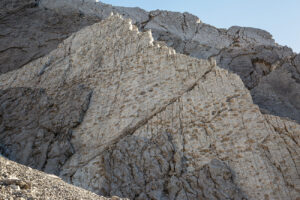Researchers have been piecing together fragments of an ancient skull to reconstruct the tadpole from hell. Crassigyrinus scotias existed 330 million years ago in the swamps of Scotland. At three meters long, with huge teeth and big eyes, the animal more closely resembled today’s crocodiles and alligators, though the name translates to ‘thick tadpole’.
A skull jigsaw
Scientists first discovered the species over a decade ago but they have struggled to learn more about it. Nearly all the fossils have been crushed, and laying the misshapen skull fragments on top of each other proved impossible to do by hand.

Photo: Porro et al
Instead, researchers have been putting the skull back together digitally. They had to painstakingly piece together the remains of four separate skulls. “Once we had identified all of the bones, it was a bit like a 3D-jigsaw puzzle. I normally start with the remains of the brain case, because that’s going to be the core of the skull, and then assemble the palate around it,” scientist Laura Porro explained.
The animal lived in coal swaps in Scotland and parts of North America during the lower to mid-Carboniferous period. It was a flat-bodied tetrapod and genetically it is very closely related to some of the earliest land animals, yet C. scotius was completely aquatic.

Photo: Porro et al
A ferocious predator
The reconstruction showed that the animal had a number of adaptations for its swamp habitat. It had huge teeth, a very strong jaw, and ridges along the skull that would have helped spread the force of the creature’s bite. These features, combined with its large size, would have made it a ferocious predator.
“It would probably have behaved in a way similar to modern crocodiles, lurking below the surface of the water and using its powerful bite to grab prey,” Porro said.
Large eyes would have helped the species to see in murky swamp water. They also found lateral lines on the skull to detect vibrations.
The reconstructed skull has a gap at the front of its snout. This gap is common among early tetrapods, but the gap in C. scotius is slightly different. It has smooth edges and is very large.
There are two possibilities for its purpose. It could have been the position of a rostral organ to help detect electric fields or it may have been a Jacobson’s organ that would have helped it detect different chemicals.
The findings of the study are published here.





